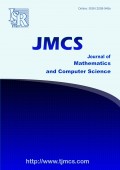Global analysis of mathematical model of infection by bacteriophages and bacteria with a mechanism of protection
Authors
M. C. Gómez
- Research Group in Mathematical Biology and Applied Mathematics (GIBIMMA), University of Nariño, Nariño, Colombia.
E. I. Mondragón
- Research Group in Mathematical Biology and Applied Mathematics (GIBIMMA), University of Nariño, Nariño, Colombia.
E. P. L. Molano
- Departament of Biology, University of Nariño, Nariño, Colombia.
Abstract
We present a mathematical model of pathogenic bacteria and bacteriophages, incorporating an abortive infection as a mechanism of bacterial protection against viral infection. We identified three equilibria: the extinction equilibrium point, the bacteriophages extinction equilibrium, and the coexistence equilibrium. The stability of these equilibria is determined by thresholds. We found that the extinction equilibrium point is always unstable, while the bacteriophages extinction equilibrium is globally asymptotically stable. The stability of the coexistence equilibrium varies, being unstable, locally asymptotically stable, or globally asymptotically stable depending on certain thresholds. We conclude that bacterial extinction is not possible, possibly due to the inclusion of the abortive infection, but it is feasible to maintain a low level of pathogenic bacteria.
Share and Cite
ISRP Style
M. C. Gómez, E. I. Mondragón, E. P. L. Molano, Global analysis of mathematical model of infection by bacteriophages and bacteria with a mechanism of protection, Journal of Mathematics and Computer Science, 39 (2025), no. 3, 338--347
AMA Style
Gómez M. C., Mondragón E. I., Molano E. P. L., Global analysis of mathematical model of infection by bacteriophages and bacteria with a mechanism of protection. J Math Comput SCI-JM. (2025); 39(3):338--347
Chicago/Turabian Style
Gómez, M. C., Mondragón, E. I., Molano, E. P. L.. "Global analysis of mathematical model of infection by bacteriophages and bacteria with a mechanism of protection." Journal of Mathematics and Computer Science, 39, no. 3 (2025): 338--347
Keywords
- Abortive infection
- Dulac function
- bacteria-virus model
- Dulac function\sep bacteria-virus model
- bacteriophages
MSC
References
-
[1]
N. Aframian, A. Eldar, Abortive infection antiphage defense systems: separating mechanism and phenotype, Trends Microbiol., 31 (2023), 1003–1012
-
[2]
G. Beke, M. Stano, L. Klucar, Modelling the interaction between bacteriophages and their bacterial hosts, Math. Biosci., 279 (2016), 27–32
-
[3]
B. Boldin, The importance of ecological dynamics in evolutionary processes: A host-bacteriophage model revisited, J. Theoret. Biol., 539 (2022), 10 pages
-
[4]
J. E. Egido, A. R. Costa, C. Aparicio-Maldonado, P. J. Haas, S. J. J. Brouns, Mechanisms and clinical importance of bacteriophage resistance, FEMS Microbiol. Rev., 46 (2022), 16 pages
-
[5]
H. I. Egilmez, A. Y. Morozov, E. E. Galyov, Modelling the spatiotemporal complexity of interactions between pathogenic bacteria and a phage with a temperature-dependent life cycle switch, Sci. Rep., 11 (2021), 13 pages
-
[6]
M. C. Gómez, E. Ibarguen Mondragon, E. L. Molano, A. Hidalgo-Troya, M. A. Mármol-Martínez, D. L. Guerrero- Ceballos, M. A. Pantoja, C. Paz-García, J. Gómez-Arrieta, M. Burbano-Rosero, Mathematical model of interaction Escherichia coli and Coliphages, Math. Biosci. Eng., 20 (2023), 9712–9727
-
[7]
M. Hasan, J. Ahn, Evolutionary dynamics between phages and bacteria as a possible approach for designing effective phage therapies against antibiotic-resistant bacteria, Antibiotics, 11 (2022), 20 pages
-
[8]
E. E. Kyaw , H. Zheng, J. Wang, Stability and hopf bifurcation analysis for a phage therapy model with and without time delay, Axioms, 12 (2023), 27 pages
-
[9]
Q. J. Leclerc, J. A. Lindsay, G. M. Knight, Modelling the synergistic effect of bacteriophage and antibiotics on bacteria: Killers and drivers of resistance evolution, PLoS Comput. Biol., 18 (2022), 26 pages
-
[10]
Q. J. Leclerc, J. Wildfire, A. Gupta, J. A. Lindsay, G. M. Knight, Growth-dependent predation and generalized transduction of antimicrobial resistance by bacteriophage, Msystems, 7 (2022), 22 pages
-
[11]
X. Li, R. Huang, M. He, Dynamics model analysis of bacteriophage infection of bacteria, Adv. Differ. Equ., 2021 (2021), 11 pages
-
[12]
A. Millman, S. Melamed, A. Leavitt, S. Doron, A. Bernheim, J. Ho¨ r, J. Garb, N. Bechon, A. Brandis, A. Lopatina, G. Ofir, D. Hochhauser, A. Stokar-Avihail, N. Tal, S. Sharir, M. Voichek, Z. Erez, J. L. M. Ferrer, D. Dar, A. Kacen, G. Amitai, R. Sorek, An expanded arsenal of immune systems that protect bacteria from phages, Cell Host & Microbe, 30 (2022), 1556–1569
-
[13]
H. M. Ndongmo Teytsa, B. Tsanou, S. Bowong, J. M.-S. Lubuma, Bifurcation analysis of a phage-bacteria interaction model with prophage induction, Math. Med. Biol., 38 (2021), 28–58
-
[14]
E. Rodríguez-Román, J. A. Manuel, D. Goldberg, B. R. Levin, The contribution of abortive infection to preventing populations of Lactococcus lactis from succumbing to infections with bacteriophage, PLoS ONE, 19 (2024), 18 pages
-
[15]
A. D. Teklemariam, R. R. Al-Hindi, I. Qadri, M. G. Alharbi, W. S. Ramadan, J. Ayubu, A. M. Al-Hejin, R. F. Hakim, F. F. Hakim, R. F. Hakim, L. I. Alseraihi, T. Alamri, S. Harakeh, The battle between bacteria and bacteriophages: a conundrum to their immune system, Antibiotics, 12 (2023), 17 pages
-
[16]
V. V. Volkova, Z. Lu, T. Besser, Y. T. Gröhn, Modeling the infection dynamics of bacteriophages in enteric escherichia coli: estimating the contribution of transduction to antimicrobial gene spread, Appl. Environ. Microbiol., 80 (2014), 4350–4362

